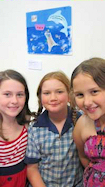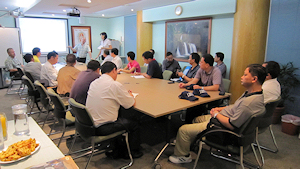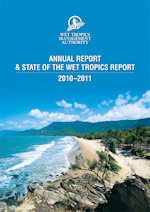Safe & Happy Christmas!

|
|
|
|
WTMA |
|
Board Update
The Board of Wet Tropics Management Authority held its 87th Board meeting in Cairns on 31 October 2011.
Joining Board Directors, Peter Valentine, Alastair Birtles and Julia Leu for the meeting were observers from the Rainforest Aboriginal community, Leah Talbot and Ernie Grant; Departmental Representatives from Queensland Parks and Wildlife (QPWS), Wolf Sievers and Peter Ogilvie, and the Chair of the Community Consultative Committee Chair, Moni Carlisle.
Key points of Board discussion included:
-
Development of a framework for the 2012-13 WTMA workplan. The Board reaffirmed WTMA’s Mission Statement from the 2008-13 Strategic Plan; i.e. to ‘Lead, inspire, advise and support the Australian and global community to protect and share the Wet Tropics World Heritage Area in perpetuity’. The Board acknowledged that new climate change legislation and recent announcements for national environmental law reform, continue to change the national and state policy and planning context in which WTMA operates.
-
Prospective National Heritage Listing of the Wet Tropics World Heritage Area for its cultural values provides opportunities to partner with Rainforest Aboriginal People, QPWS and others in the region.
-
Presentation of the Scientific Advisory Committee (SAC) discussion paper; WTMA’s Strategic Direction for Responding to Climate Change. The paper responds to the management challenge posed by Climate Change on the integrity of the World Heritage Area.
Farewell to outgoing QPWS Officer, Peter Ogilvie. Peter is retiring after serving 46 years in the public service.
>> For a summary of the Board meeting click here.
|
IUCN appointment
WTMA Executive Director, Andrew Maclean, has recently been elected Chair of the Australian Committee for IUCN.
WTMA has for many years been a member of the IUCN – the International Union for the Conservation of Nature. IUCN is one of the oldest and most respected international conservation organisations. It has a presence on every continent with members ranging from national governments to small voluntary conservation organisations. Of particular interest to WTMA is the role IUCN has in relation to natural World Heritage places. It evaluates natural World Heritage Sites nominated for World Heritage Status, monitors the state of conservation of existing Sites, implements capacity building initiatives, and provides technical advice to the World Heritage Committee. Visit www.iucn.org.
The Australian Committee for IUCN assists in coordinating the activities of IUCN members in Australia and helps members gain maximum value from their membership of this international organisation. WTMA has been pleased to support a reinvigoration of the ACIUCN in the last 18 months. Contributions from members, in particular Parks Australia and Parks Victoria, have enabled the appointment of Ms Penny Figgis AO as the national committee’s first full time director.
One of the main activities of ACIUCN is to organise symposia and similar events to support information exchange in support of nature conservation. WTMA is in discussion with ACIUCN about a proposal for a symposium on a World Heritage theme, likely to be held in Cairns in July 2012.
Another significant IUCN event on the 2012 calendar is the World Conservation Congress to be held in Jeju, South Korea in September. WTMA, with support from Scientific Advisory Committee members has contributed a proposal for a conference event aimed at advancing WTMA’s goals of establishing the Wet Tropics World Heritage Area as a learning landscape.
The other ACICUN committee members elected this month were Peter Cochrane, (Commonwealth) Director of National Parks, Denise Boyd of the Australian Conservation Foundation and Peter Owen of the Wilderness Society. Professor Brendan Mackey is an ex officio member through his role as an Oceania Regional Councillor for IUCN. |
|
|
Become a
Facebook
fan!
WTMA has
initiated a
Wet Tropics
World
Heritage
Fan Page on
Facebook...follow
us and keep
up to date
on
activities
in the Wet
Tropics and
the wider
World
Heritage
Community.
|
|
|
|
|
|
|
Communities and
Partnerships |
World Heritage Gateway Study
A pre-feasibility study of a World Heritage Gateway in Cairns is underway. The study, jointly funded by WTMA and the Queensland Government, will further develop a concept for a centre that will orient visitors to the Wet Tropics, the Great Barrier Reef and other World Heritage places in Australia. Tourism consultancy firm EC3 will undertake the study and will consult widely among regional stakeholders in preparing the report.
>>
Further information
here.
|
Cassowary Awards 2011
The new interpretive centre at the Cairns Botanic Gardens provided a contemporary and elegant venue for the 2011 Wet Tropics Management Authority’s Cassowary Awards on Saturday November 5.
More than 100 people gathered in the modern surrounds of the centre and amphitheatre admiring artwork and visual displays before the Cassowary Award presentations were underway.
Some of the World Heritage Area’s most inspirational people from backgrounds such as science, art, Rainforest Aboriginal culture were applauded for their tireless work in the Wet Tropics.
WTMA Board Chair Assoc Prof Peter Valentine said the Cassowary Awards continue to flourish every year.
“We are delighted to see the very high numbers of award nominations from the various sectors of World Heritage management, conservation, research and presentation. With the urgent need for higher investment for the future health of our environment, it is vital that we have a community that values, respects and cares for our World Heritage Area”.
Nature photographer Steven Nowakowski received an award in the category of Arts for his portrayal of Wet Tropics destinations that evoke passion and appreciation for the World Heritage Area.
|
Mr Nowakowski said he was thrilled to be acknowledged by WTMA and the Wet Tropics community for his photographic skills and volunteer work supporting environmental causes.
“You could say I have one of the best jobs in the world. I get to take photos of some of the most beautiful landscapes in the world, and they are right here in our backyard. We are extremely lucky as a community to live nestled in a tropical green paradise and we should never take it for granted,” Mr Nowakowski said.
For a full list of Cassowary Award recipients click
here. |

Cassowary Award winners for the Science Category
L-R Dr Trevor Whiffin, Rebel Elick, Siobhan Duffy, Frank Zich. |
|
|
|
Winners of
the Reef and
Rainforest:
Keep it Wild
poster
competition
2011 |
|
An awesome 320 entries were received for this year’s Reef and Rainforest Keep It Wild Poster Competition. Judges had a difficult time choosing a short list from the entries that were thought provoking and highly entertaining.
WTMA project officer and coordinator of the competition Lana Lopatich said the poster competition grows in popularity every year.
“It’s so exciting to see the high calibre of entries and the ideas that the students come up with for their poster themes. It’s a really fun process for staff and judges to view and vote on the artwork,” she said.
The Cairns Regional Gallery hosted the award ceremony on 16 September. Students, teachers and parents gathered to admire the finalists’ artwork that was featured in the gallery and to cheer on the winners. |

Poster competition winners Jessica Mitchell, Riley Thatcher and Isabell Azcuene from St Andrews Catholic College
|
This year’s
challenge
was to
submit an
eye-catching
poster
designed to
change the
way people
feel, think
and act
about their
impact on
the earth.
Students
submitted
colourful
and vibrant
artwork
featuring
cassowaries,
tree frogs
and some
impressive
sea anemones
with an
important
conservation
message!
Winners
received
passes to
visit the
Great
Barrier Reef
and Skyrail.
The awards
were
presented by
Andrew
Maclean (Wet
Tropics
Management
Authority),
Doon McColl
(Great
Barrier Reef
Marine Park
Authority),
Max Sheppard
(Skyrail
Rainforest
Cableway)
and Tanya
Andacic (Big
Cat Green
Island Reef
Cruises).
The
impressive
winning
entries have
been
compiled
into a
delightful
calendar
with an
environmental
message for
2012.
For a full
list of
winners and
to download
the calendar
click
here.
|

|
|
WTMA
participates
in
Tablelands
community
planning
WTMA
Principal
Project
Officer,
Patricia
O’Loghlen,
participated
in a series
of ‘Think
Tanks’
coordinated
by the
Tablelands
Regional
Council
during
August. The
Think Tanks
aimed to
stimulate
creative
thinking
around
future
trends and
impacts on
the
Tablelands
community
and its
environment.
They were
attended by
about 100
locals from
the Cairns
and
Tableland
region and
themes
included
Population,
Lifestyle
and
Wellbeing;
Adapting to
out Changing
Environment,
Resource
Base – A
More
Sustainable
Future and
Globalisation
versus
Localisation.
“The Think
Tanks
invoked
thoughtful
discussion
about how
the
Tablelands
could be
affected by
both local
and global
trends. It
also
reinforced
how
important it
is to
maintain a
healthy
environment
which
includes
natural
areas that
people enjoy
and benefit
from
socially,
physically
and
psychologically,”
Ms O’Loghlen
said.
Following on
from the
Think Tanks,
Ms
O’Loghlen,
along with
around 220
people from
the
Tablelands
and local
area,
attended the
Council’s
Tablelands
Community
Plan
Regional
Summit in
September.
The regional
summit
presented
the
framework
for 20
Community
Plans and
seven
Indigenous
Plans. The
plans aim to
provide a
greater
awareness of
community
aspirations;
to advance
projects and
initiatives
and give
more clout
when
negotiating
priorities;
and to guide
and inform
Council
planning.
Participants
at the
Summit were
given the
opportunity
to review
the input
provided by
communities
and to add
further
issues or
aspirations.
The Wet
Tropics
World
Heritage
Area was
considered
in the plans
and
additional
input into
the plans
was provided
on the day.
These
included
ideas about
the World
Heritage
Area being
important
for the
wellbeing of
the
community
and playing
a
significant
role in the
life of the
community.
The impact
of climate
change on
the Wet
Tropics was
also noted
in the
community
plans. The
plans are
expected to
be available
for comment
from 12
December
2011 to 16
January
2012.
|
|
|
|
|
|
|
|
Planning and Conservation |
|
Chinese delegation gets friendly with cassowary
WTMA’s fibreglass cassowary situated in the foyer of the office posed for photo opportunities for a delegation of 20 Chinese officials who visited WTMA on 9 November. The fibreglass replica was the first cassowary the delegation had seen since arriving in Cairns and proved to be quite a hit.
The delegation was visiting WTMA to gain an overview of the Authority’s roles and responsibilities in management of the Wet Tropics World Heritage Area.
The visitors were from Guangdong Nature Reserve Management Office and included the Directors and Deputy Directors of Nature Reserves from around the Province. Guangdong Province is the richest province in China in terms of GDP and is located next to Hong Kong.
Through an interpreter, WTMA staff provided a brief history of the Wet Tropics World Heritage Area and gave delegates an insight into the instruments and management tools used in planning and supporting management of the Area.
Delegates were also briefed on the role of tourism and community partnerships. Participants raised a number of questions relating to management arrangements and were particularly interested in the legislation and organisational structures governing the Wet Tropics. The visitors showed their appreciation by providing staff with baseball caps and documents about nature reserves in Guangdong Province.
|
|

WTMA Communities and Partnerships Manager Dr Paul Chantrill addresses the Chinese delegation |
|
|
WTMA’s
Annual
Report and
State of the Wet
Tropics
Report
2010-2011
Copies of
the WTMA
Annual
Report and
State of the
Wet Tropics
Report are
now
available on
our website.
For your
copy click
here
(note: large
file).
|
The WTMA 2011 State of the Wet Tropics Report focussed on the risks created to the outstanding universal values of the Wet Tropics World Heritage area by exotic pests, weeds and disease in and around the World Heritage Area.
Over 508 exotic plants have become established in the Wet Tropics World Heritage Area – that’s nearly 40 percent of Queensland’s total weeds.
The Report states that biosecurity threats to the World Heritage Area have increased with the mobility of people, plants, and animals - and that they will be magnified by climate change, interacting with wetter wet seasons and longer and dryer dry seasons. Many of these threats are almost impossible to control once they become established. |

|
WTMA
Executive
Director,
Andrew
Maclean said
that recent
detection of
the
devastating
fungal
infection,
Myrtle Rust,
highlighted
the gaps in
the
biosecurity
of
environmental
threats.
“Myrtle Rust
is fungus
that
threatens
the
Myrtaceae
plant
family, one
of the
largest
native plant
families in
Australia.
The Wet
Tropics has
211 species
of Myrtaceae
including
paperbarks,
melaleuca,
lilly pilly,
golden
penda,
eucalypts
and tea
trees to
name a few.
We are very
concerned
about the
threat this
fungus poses
to the
diversity
and health
of our World
Heritage
Area,” he
said.
Other
biosecurity
threats to
the Wet
Tropics
World
Heritage
Area
include:
-
Asian
Honeybee
– an
exotic
bee that
may
interfere
with
pollination
of
native
plants
and
compete
with
native
insects
and
wildlife
as well
as
posing a
threat
to the
apiary
industry
-
Phytopthora
– a root
fungus
that
threatens
hundreds
of the
region’s
unique
rainforest
plants
-
Chytrid
fungus –
has
contributed
to the
extinction
of
several
species
of Wet
Tropics
endemic
rainforest
stream-dwelling
frogs
from
altitudes
above
300
metres
-
Tramp
ants –
are
increasing
in range
and
threaten
ground
dwelling
reptiles,
mammals
and
birds
-
Tilapia
– this
exotic
fish is
rapidly
invading
many of
the
major
rivers
and
streams
A key
message of
the report
is that
pests, weeds
and disease
that
threaten
native
ecosystems
are
currently
receiving
lower
priority and
investment
compared to
that given
to similar
threats to
of
agricultural
systems.
|
WTMA gets a
mention in
the Senate
Queensland
Senator Jan
McLucas rose
in the
Senate
recently to
commend the
work of the
Wet Tropics
Management
Authority. A
link to the
Hansard
extract of
her speech
is
here.
Thanks to
Senator
McLucas for
her kind
words and
support. |
|
|
Full steam
ahead to
make the
connections
|
It’s all stations go for the Making Connections connectivity project on the Southern Atherton Tablelands, with the coming Wet Season promising to be a busy time!
This collaborative project, funded by the Australian Government's Caring for our Country initiative, will help to restore connectivity between the World Heritage Area and patches of remnant rainforest on private lands at Rock Road (Upper Barron) and the East Evelyn Gap. Increasing habitat and restoring wildlife corridors in these critical high altitude locations, will help to buffer many iconic Wet Tropics species, like tree kangaroos and ringtail possums, from the effects of climate change. |

Students from the Centre for Rainforest Studies monitoring the 2011 planting
|
Fencing is
being
erected on
several
private
properties
over the
next few
months to
protect new
plantings
from cattle.
The
Tablelands
Regional
Council’s
Community
Revegetation
Unit is
preparing
the
remaining
sites for
planting.
The 6,000
trees over 2
hectares
planted in
early 2011
have
survived
well,
despite the
very dry
winter. A
further 4
hectares
will be
planted in
2012.
Why not come
and join us
at one of
the
community
plantings
mornings and
sausage
sizzles at
the East
Evelyn Gap
on Saturday
28 January
and Saturday
18 February
(weather
permitting).
Contact Deb
Pople at
WTMA nearer
the time for
details, or
look for
more
information
in the TREAT
and TKMG
newsletters.
We’re also
moving
forward on
the science
front. Dr
Luke Shoo (UQ/JCU)
and
Professor
Carla
Catterall
(Griffith
University)
are working
with Kylie
Freebody and
Conservation
Volunteers
Australia to
set up
microhabitat
trials and
pasture
conversion
plots to try
out more
cost-effective
ways of
encouraging
natural
regeneration.
During
November,
volunteers
will be
helping to
mark out the
plots and
install
piles of
logs and old
fence posts
(sourced
from nearby
properties
and cyclone
tree-fall)
to encourage
faster
colonisation
of
invertebrates
and reptiles
in recently
replanted
areas. Dr
Rohan Wilson
and students
from the
Centre for
Rainforest
Studies
(School for
Field
Studies) in
Yungaburra
will be
helping to
monitor the
plots and
record
changes in
condition
and
diversity.
|
|
|
|
Tropical Topics |
|
|
|
 |
|
Bats |
|

>>
Read more on
Tropical
Topics
here.
|
|
|
|
|
|
|
 |
|
Sent to: ,[Email],
Unsubscribe |
Subscribe |
Previous issues |
Update your details
This is a private mailing list - your
privacy is important. Should you no longer wish to receive
this newsletter from us please unsubscribe
here
- email address receiving this is [email]. To ensure your edition is received every time,
add
us to your safe senders.
t: 07
4052 0542 | f: 07
4031 1364
a: 1st Floor, 15 Lake Street, P O Box 2050, Cairns Q
4870
Visit our web site |
email us here
|
|
|











